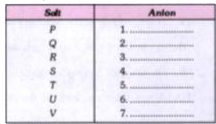Calcium acetate on heating gives ___ which gives__ on heating with iodine and sodium hydroxide solution.
Step by step video solution for Calcium acetate on heating gives ___ which gives__ on heating with iodine and sodium hydroxide solution. by Chemistry experts to help you in doubts & scoring excellent marks in Class 12 exams.
Updated on:21/07/2023Topper's Solved these Questions
- ISC QUESTION PAPERBOOK - ICSECHAPTER - ISC QUESTION PAPEREXERCISE - PART-II(SECTION-A)
33 Videos
- ISC QUESTION PAPERBOOK - ICSECHAPTER - ISC QUESTION PAPEREXERCISE - PART-II(SECTION-B)
74 Videos
- HALOALKANES AND HALOARENES BOOK - ICSECHAPTER - HALOALKANES AND HALOARENES EXERCISE - SOURCE
9 Videos
- ORGANIC COMPOUNDS CONTAINING NITROGENBOOK - ICSECHAPTER - ORGANIC COMPOUNDS CONTAINING NITROGENEXERCISE - ISC EXAMINATION QUESTIONS ( PART-II DESCRIPTIVE QUESTIONS)
33 Videos
Similar Questions
Knowledge Check
Propanal on treatment with dilute sodium hydroxide gives
ACH3CH2CH2CH2CH2CHOBCH3CH2CH(OH)CH2CH2CHOCCH3CH2CH(OH)CH(CH3)CHODCH3CH2COOHHydroxide of which metal is soluble in sodium hydroxide solution?
AMagnesiumBLeadCSilverDCopper
Write the balanced chemical equation for the following reaction :
Zinc is heated with sodium hydroxide solution.
View SolutionGive balanced chemical equations for the following reactions :
Fluorine treated with dilute sodium hydroxide solution
View SolutionWhich is the major product formed when acetone is heated with iodine and potassium hydroxide ?
View SolutionA compound (X) with the molecular formula C6H10O4 is a neutral liquid. On heating (X), under reflux with aqueous sodium hydroxide and distilling the product. A colourless liquid is obtained which on warming with iodine and aqueous sodium hydroxide gives a pale yellow precipatate (Y). The residue in the distilling flask is the sodium salt of an acid (Z), which decolourises aqueous acidified potassium permaganate (VII) on heating. Identify (X),(Y), and (Z) and give all the reactions involved.
View SolutionSalts P, Q,R,S,T,U and V undergo reactions (i) to (vii) respectively. Identify the cation present in these salts on the basis of these reactions. Tabulate your answer in the formate given below.
(i) When the salt Pis heated with sodium hydroxide solution a vigorous reaction takes place and a colourless gas is evolved with a pungent and suffocating smell that brings tears in our eyes. The evolved gas gives dense white fumes with a moist glass rod depped with hydrochloric acid.
(ii) Addition of sodium hydroxide solution to a solution of salt Q gives a thick white precipitae which is soluble in excess of sodium hydroxide solution to form a clear solution.
(iii) Addition of ammonium hydroxide solution to a solution of salt R gives a dark blue precipitate which is soluble is excess of ammonium hydroxide solution to form an intense deep blue solution.
(iv) Addition of ammonium hydroxide solution to a solution of 5 gives a dirty green [bottle green] precipitate which is insoluble even in the excess of ammonium hydroxide solution.
(v) Addition of ammonium hydroxide solution to a solution of T gives a reddish brown (rust precipitate] precipitate which is insoluble even in the excess of ammonium hydroxide solution.
(vi) Addition of ammonium hydroxide solution to a solution of V gives a geletaneous white precipitate which is soluble in excess of ammonium hydroxide solution to form a clear solution.
(vii) Addition of ammonium hydroxide solution to a solution of V gives no precipitate but it gives a chalky white precipitate with sodium hydroxide solution which is insoluble even in the excess of sodium hydroxide solution.

View SolutionWhich of the following disproportionate (s) in heating with sodium hydroxide?
View Solution
